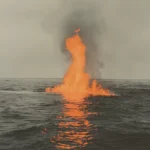When you think about the ocean, you might picture a vast blue space that stays mostly the same. But scientists have found something surprising. According to University of Auckland research, our oceans are warming up in very specific bands or strips, almost like hot belts around the Earth.
Dr. Kevin Trenberth, a climate scientist from University of Auckland and the National Center for Atmospheric Research (NCAR), led this important study with several other researchers from around the world.
The research team carefully studied ocean temperatures from 2000 to 2023, looking at how much the water has heated up compared to earlier years. What they found was not what anyone expected. Instead of warming evenly, the oceans are getting much hotter in two specific bands around the globe at certain distances from the equator.
Where These Hot Bands Are Located
| Heat Band | Location | Areas Affected |
|---|---|---|
| Southern Band | 40-45 degrees south | Waters around New Zealand, Tasmania, east of Argentina |
| Northern Band | 40 degrees north | Waters east of US, east of Japan |
| Tropical Region | 10°N to 20°S | Tropical waters showing additional warming |
The southern band near New Zealand is actually warming faster than anywhere else, which is a big concern for that region. What makes this discovery so interesting is that areas around 20 degrees latitude (both north and south of the equator) aren’t warming much at all, creating a strange pattern of hot and normal zones.
Why Ocean Warming Happens in These Specific Places
You might wonder why the ocean gets hotter in these specific bands. The answer has to do with something called jet streams. Think of jet streams as rivers of fast-moving air high up in the sky that separate cold air near the poles from warmer air near the equator.
- Jet streams are like highways of wind that circle the Earth high in the sky that blow from west to east
- Climate change is making these jet streams move closer to the poles
- When jet streams move, they change the wind patterns at the ocean surface
- These changed winds push ocean water in new directions
- This movement creates concentrated warming in specific latitude bands
Dr. Trenberth explains that these changes are directly linked to greenhouse gases building up in our atmosphere. “Despite what Donald Trump thinks, the climate is changing because of the build-up of greenhouse gases, and most of the extra heat ends up in the ocean,” said Trenberth.
How This Affects Sea Life and Weather
When ocean areas heat up like this, it creates big problems for the animals and plants that live there. Many sea creatures can only survive in certain temperature ranges, and when their home suddenly gets too warm, they either move or die.
- Fish species are moving north along the US East Coast, changing where fishermen can catch them
- Marine heatwaves in the Northeast Pacific are disrupting food chains
- Rapid warming near New Zealand is threatening local marine ecosystems
- Coral reefs in tropical regions are experiencing more bleaching events
- Important commercial fish species are changing where they live
The warming oceans also put more water vapor into the air. This can fuel stronger storms and change rainfall patterns, potentially leading to more extreme weather events where you live.
How Scientists Measured These Ocean Changes
To find these warming patterns, the research team had to process huge amounts of data. They looked at ocean temperatures down to 2000 meters deep (that’s deeper than 10 football fields stacked end-to-end), dividing the ocean into strips just 1 degree of latitude wide.
They measured heat in units called zettajoules, which are incredibly large energy measurements. To give you an idea, one zettajoule is roughly equal to 63 million hydrogen bombs. The researchers compared recent measurements to a baseline from 2000-2004 to see how much things had changed.
What Scientists Say About This Discovery
Dr. Trenberth was amazed by what they found. “This is very striking… It’s unusual to discover such a distinctive pattern jumping out from climate data,” he explained. The research team included Lijing Cheng and Yuying Pan from the Chinese Academy of Sciences, John Fasullo from NCAR, and Michael Mayer from the University of Vienna and European Centre for Medium-Range Weather Forecasts.
These warming bands have been developing since around 2005, and they’re likely to continue growing as climate change progresses. Scientists are now watching these areas closely to better understand how they might affect weather patterns and marine life in the coming years.
What This Means for Our Future Climate
As you hear about extreme weather events or changes in fish populations, these ocean heat bands might be playing a big role. The warming is happening because of greenhouse gases trapping heat in our atmosphere, with most of that extra heat ending up in the oceans.
The discovery of these specific heating patterns helps scientists better understand how climate change affects our planet in complex ways. It’s not just about everything getting warmer everywhere – it’s about specific patterns that can have different effects in different places.
As research continues, you’ll likely hear more about how these ocean heat bands are changing our world. The big question now is whether we can slow these changes by reducing greenhouse gas emissions before more marine ecosystems are damaged beyond repair.











